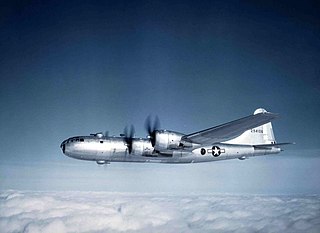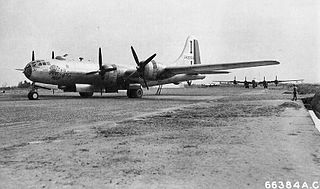
Operation Matterhorn was a military operation of the United States Army Air Forces in World War II for strategic bombing by Boeing B-29 Superfortress bombers based in India, Ceylon and China. Targets included industrial facilities in Japan, China and Southeast Asia.

The XX Bomber Command was a United States Army Air Forces bomber formation. Its last assignment was with Twentieth Air Force, based on Okinawa. It was inactivated on 16 July 1945.

The 58th Air Division is an inactive United States Air Force unit. Its last assignment was with Air Defense Command, based at Wright Patterson Air Force Base, Ohio. It was inactivated on 1 February 1959.

The 468th Bombardment Group was a World War II United States Army Air Forces combat organization. The unit served primarily in the Pacific Ocean theater and China Burma India Theater of World War II as part of Twentieth Air Force. The 468th Bomb Group's aircraft engaged in very heavy bombardment Boeing B-29 Superfortress operations against Japan. After its reassignment to the Mariana Islands in 1945, its aircraft were identified by a "I" and a triangle painted on the tail. It was inactivated on 31 March 1946.

The 346th Bombardment Group is a former United States Army Air Forces unit. It was last assigned to the 316th Bombardment Wing at Kadena Airfield, Okinawa, where it was inactivated on 30 June 1946. The group was originally a heavy bomber training unit, but was inactivated in a general reorganization of Army Air Forces training units in 1944. It was reorganized as a Boeing B-29 Superfortress group later that year. It moved to Okinawa in 1945, but arrived too late to participate in combat.

The 382d Bombardment Group is a former United States Army Air Forces unit. It was last stationed at Camp Anza, California, where it was inactivated on 4 January 1946. The group was active from 1942 to 1944 as a heavy bomber training unit. It was reorganized as a very heavy bomber unit and trained for deployment overseas. However, it arrived at its overseas station too late to see combat, and returned to the United States, where it was inactivated.

The 512th Rescue Squadron is part of the 58th Special Operations Wing based at Kirtland Air Force Base, New Mexico. It formerly operated the Bell UH-1N Twin Huey and currently operates the Sikorsky HH-60G Pave Hawk and the new HH-60W Jolly Green II helicopters training aircrew conducting search and rescue missions.

The 6th Attack Squadron is an active United States Air Force unit, assigned to the 49th Wing at Holloman Air Force Base, New Mexico. The squadron is a formal training unit for crews learning to operate unmanned aerial vehicles.

The 435th Bombardment Squadron, also known as the "Kangaroo" Squadron, is an inactive United States Air Force unit. It was formed in Australia in March 1942 as the 40th Reconnaissance Squadron and participated in combat in the Southwest Pacific Theater until November, when it was withdrawn from combat and returned to the United States, where it acted as a Replacement Training Unit until October 1943, when its personnel and equipment were withdrawn.

Kalaikunda Air Force Station (ICAO: VEDX) is an Indian Air Force Base in Kharagpur, located in the West Midnapur district of the state of West Bengal. It was the home of No. 18 Squadron IAF, the Flying Bullets. The squadron flew the Indian license-built Mikoyan MiG-27ML till its decommissioning in April 2016. A squadron of Su-30 MKIs is now at the base.

Piardoba Airfield is an abandoned airfield in India, located 6.6 miles (10.7 km) S of Bishnupur, West Bengal, Bankura District in the state of West Bengal, India.
Pengshan Air Base is a People's Liberation Army Air Force (PLAAF) air base, located approximately 1 km east of Gongyi Town, in Pengshan County, Sichuan province, Southwestern China.

The 768th Bombardment Squadron is an inactive United States Air Force unit. It was last assigned to the 462d Strategic Aerospace Wing at Larson Air Force Base, Washington, where it was inactivated on 25 June 1966. The squadron was first activated in 1943, and became one of the earliest Boeing B-29 Superfortress units. It moved to the China Burma India Theater in April 1944 and participated in the first attack on the Japanese Home Islands since the 1942 Doolittle Raid on 15 June 1944. It earned three Distinguished Unit Citations. The squadron moved to Tinian with the rest of the 58th Bombardment Wing in April 1945 and continued its participation in the strategic bombing campaign against Japan until V-J Day. In November 1945, it returned to the United States, where it was inactivated in April 1946.

The 769th Bombardment Squadron is a former United States Army Air Forces unit. It was last assigned to the 462d Bombardment Group at MacDill Field, Florida, where it was inactivated on 31 March 1946. The squadron was first activated in 1943, and became one of the earliest Boeing B-29 Superfortress units. It moved to the China Burma India Theater in April 1944 and participated in the first attack on the Japanese Home Islands since the 1942 Doolittle Raid on 15 June 1944. It earned three Distinguished Unit Citations. The squadron moved to Tinian with the rest of the 58th Bombardment Wing in April 1945 and continued its participation in the strategic bombing campaign against Japan until V-J Day. In November 1945, it returned to the United States, where it was inactivated in April 1946.

The 770th Bombardment Squadron is a former United States Army Air Forces unit. It was last assigned to the 462d Bombardment Group at MacDill Field, Florida, where it was inactivated on 31 March 1946. The squadron was first activated in 1943, and became one of the earliest Boeing B-29 Superfortress units. It moved to the China Burma India Theater in April 1944 and participated in the first attack on the Japanese Home Islands since the 1942 Doolittle Raid in June 1944. It earned its three Distinguished Unit Citations. The squadron moved to Tinian with the rest of the 58th Bombardment Wing in April 1945 and continued its participation in the strategic bombing campaign against Japan until V-J Day. In November 1945, it returned to the United States, where it was inactivated.
The 771st Bombardment Squadron is a former United States Army Air Forces unit. The squadron was activated in 1943, and became one of the earliest Boeing B-29 Superfortress units. It moved to the China Burma India Theater in April 1944 and participated in the first attack on the Japanese Home Islands since the 1942 Doolittle Raid in June 1944. In August 1944, it earned a Distinguished Unit Citation. It was inactivated on 12 October 1944, when the Army Air Forces reorganized its very heavy bomber groups to consist of three, rather than four squadrons.

The 68th Air Refueling Squadron is an inactive United States Air Force unit. It was last assigned to the 305th Bombardment Wing at Bunker Hill Air Force Base, Indiana, where it was inactivated on 25 March 1965.

The 702d Tactical Air Support Squadron is an inactive United States Air Force unit. It was part of the 601st Tactical Air Control Wing at Bergstrom Air Force Base, Texas, from 1969 until it was inactivated on 30 November 1975.

The 782nd Tactical Air Support Training Squadron is an inactive United States Air Force unit. The squadron's most distinguished predecessor is the 792nd Bombardment Squadron, which was organized in 1943 as one of the first Boeing B-29 Superfortress units, The squadron participated in the strategic bombing campaign against Japan, earning three Distinguished Unit Citations. It returned to the United States following V-J Day and briefly became one of the first units in Strategic Air Command before inactivating at the end of March 1946.

The 793d Bombardment Squadron is a former United States Army Air Forces unit. The squadron was organized in 1943 as one of the first Boeing B-29 Superfortress units. After training in the United States, The squadron moved to India and participated in the strategic bombing campaign against Japan. When bases in the Mariana Islands became available, the squadron moved to Tinian, where it was able to strike targets in Japan without staging through forward bases. It earned three Distinguished Unit Citations during its combat tour. It returned to the United States following V-J Day and briefly became one of the first units in Strategic Air Command before inactivating at the end of March 1946.


















